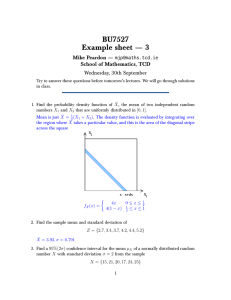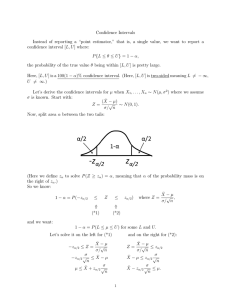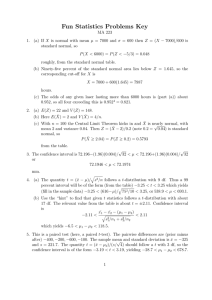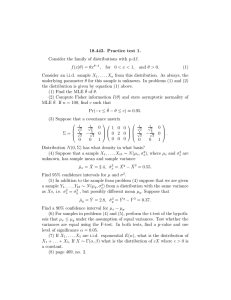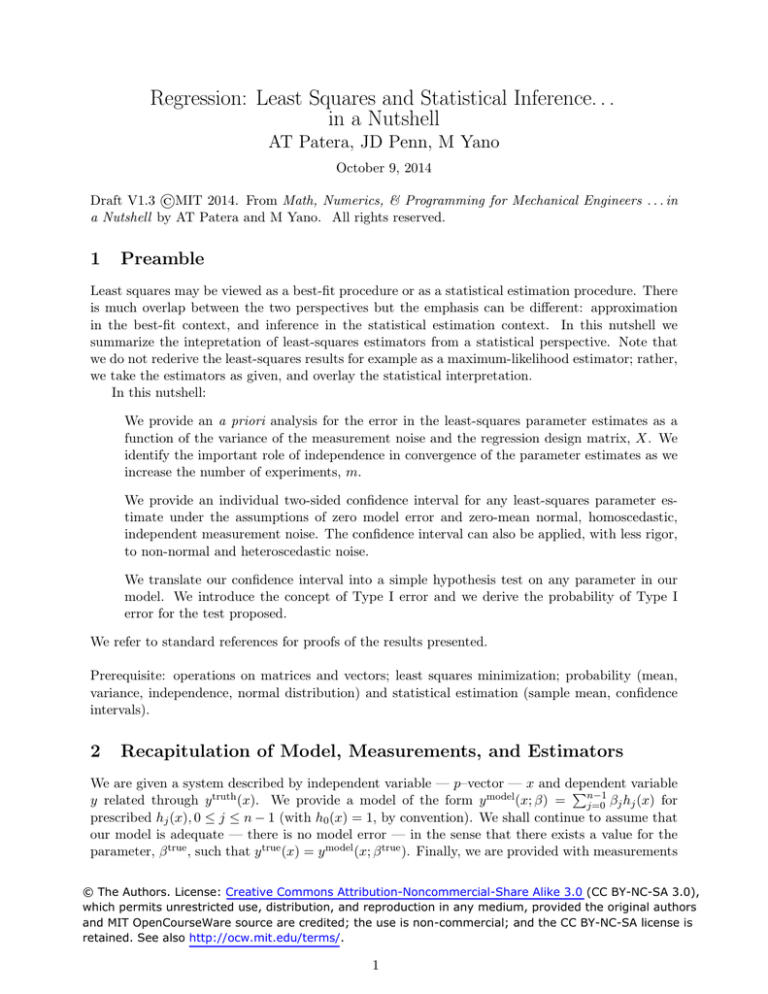
Regression: Least Squares and Statistical Inference. . .
in a Nutshell
AT Patera, JD Penn, M Yano
October 9, 2014
Draft V1.3 ©MIT 2014. From Math, Numerics, & Programming for Mechanical Engineers . . . in
a Nutshell by AT Patera and M Yano. All rights reserved.
1
Preamble
Least squares may be viewed as a best-fit procedure or as a statistical estimation procedure. There
is much overlap between the two perspectives but the emphasis can be different: approximation
in the best-fit context, and inference in the statistical estimation context. In this nutshell we
summarize the intepretation of least-squares estimators from a statistical perspective. Note that
we do not rederive the least-squares results for example as a maximum-likelihood estimator; rather,
we take the estimators as given, and overlay the statistical interpretation.
In this nutshell:
We provide an a priori analysis for the error in the least-squares parameter estimates as a
function of the variance of the measurement noise and the regression design matrix, X. We
identify the important role of independence in convergence of the parameter estimates as we
increase the number of experiments, m.
We provide an individual two-sided confidence interval for any least-squares parameter es­
timate under the assumptions of zero model error and zero-mean normal, homoscedastic,
independent measurement noise. The confidence interval can also be applied, with less rigor,
to non-normal and heteroscedastic noise.
We translate our confidence interval into a simple hypothesis test on any parameter in our
model. We introduce the concept of Type I error and we derive the probability of Type I
error for the test proposed.
We refer to standard references for proofs of the results presented.
Prerequisite: operations on matrices and vectors; least squares minimization; probability (mean,
variance, independence, normal distribution) and statistical estimation (sample mean, confidence
intervals).
2
Recapitulation of Model, Measurements, and Estimators
We are given a system described by independent variable — p–vector — x and dependent
variable
en−1
y related through y truth (x). We provide a model of the form y model (x; β) =
β
h
j
j (x) for
j=0
prescribed hj (x), 0 ≤ j ≤ n − 1 (with h0 (x) = 1, by convention). We shall continue to assume that
our model is adequate — there is no model error — in the sense that there exists a value for the
parameter, β true , such that y true (x) = y model (x; β true ). Finally, we are provided with measurements
© The Authors. License: Creative Commons Attribution-Noncommercial-Share Alike 3.0 (CC BY-NC-SA 3.0),
which permits unrestricted use, distribution, and reproduction in any medium, provided the original authors
and MIT OpenCourseWare source are credited; the use is non-commercial; and the CC BY-NC-SA license is
retained. See also http://ocw.mit.edu/terms/.
1
(xi , yimeas ), 1 ≤ i ≤ m, where yimeas = y true (xi ) + Ei , and Ei is the measurement error, or “noise.” We
shall assume here that the noise is zero-mean normal, homoscedastic with unknown variance σ 2 ,
and independent: for i = 1, . . . , m, E(Ei ) = 0, E(E2i ) = σ 2 , and E(Ei Ek ) = 0, k = i.
Our least squares procedure shall then generate, for a particular realization of our experiment,
an estimate βˆ for β true . We recall that β̂ satisfies the normal equations,
(X T X)β̂ = X T y meas ,
(1)
where X is the design matrix given by Xij = hj (xi ), 1 ≤ i ≤ m, 0 ≤ j ≤ n − 1. (Recall that the
columns of X are indexed from 0.) We presume that the columns of X are independent such that
(1) admits a unique solution, which we may thus write explicitly as
βˆ = (X T X)−1 X T y meas .
(2)
ˆ for y true (x). We recall
Once armed with β̂ we may also construct our estimate ŷ(x) = y model (x; β)
that, for 1 ≤ i ≤ m,
(Xβ true )i = y true (xi )
and
(Xβ̂)i = ŷ(xi ) ,
(3)
where (Xβ true )i (respectively, (Xβ̂)i ) refers to the ith entry of the m-vector Xβ true (respectively,
m-vector Xβ̂).
In this nutshell we will understand the error in our estimator βˆ: we present in Section 3 a priori
error bounds; we provide in Section 4 (a posteriori) confidence intervals. Although for the most part
we retain our hypotheses — on the model and the measurement noise — in force, we shall also
consider the extent to which the accuracy of our estimators, and our assessment of these estimators,
degrades as our hypotheses are violated. In Section 3 we shall briefly discuss, in the context of a priori
error analysis, the effect of model error, and also the effect of dependence (or correlation) in the
measurement errors. In Section 4 we shall briefly discuss, in the context of confidence intervals, the
effects of non-normality and heteroscedasticity — non-uniform variance for those with single-jointed
tongues — of the measurement errors. We shall see that, in fact, some departure from ideal
conditions can be readily accommodated, in particular in the case of a “well-designed” experiment.
3
A Priori Analysis
We provide here an analysis of the expected error. In the next section we translate these results
into confidence intervals.
We first define the error in our parameter estimate, e: e is an n–vector with components
ej ≡ βˆj − βjtrue , 0 ≤ j ≤ n − 1; we may thus write β̂j = βjtrue + ej , 0 ≤ j ≤ n − 1, or in vector form,
βˆ = β true + e .
(4)
We also recall the error in our experimental measurements, E: E is an m–vector with components
Ei ≡ yimeas − y true (xi ), 1 ≤ i ≤ m; we may thus write yimeas = y true (xi ) + Ei , 1 ≤ i ≤ m, or in vector
form, from (3),
y meas = Xβ true + E .
2
(5)
We can now insert (4) and (5) into (1) to obtain
(X T X)(β true + e) = X T (Xβ true + E) ,
(6)
(X T X)e = X T E .
(7)
which directly simplifies to
This “error equation” connects the errors in the measurements to the errors in the parameter
estimate through the “intermediary” of the design matrix, X.
We first present a general bound for ded, the norm of e — the sum of the square of the error
in each of our n parameters – in terms of dEd, the norm of E — the sum of the square of the
error in each of our m measurements. In particular, it is not difficult to demonstrate that, for any
realization of our experiment,
ded ≤
1
dEd ,
νmin
(8)
where νmin is the minimum singular value of the matrix X. (This minimum singular value may
also be expressed as the square root of the smallest eigenvalue of (X T X).) This estimate is often
quite pessimistic, as we shall see below. However, it demonstrates the connection between E and
e through X (and νmin ). The matrix X is determined by our model hj , 0 ≤ j ≤ n − 1, and the
measurement points xi , 1 ≤ i ≤ m. As we discussed earlier, we typically choose the (linearly
independent) hj , 1 ≤ j ≤ n − 1, to approximate well the anticipated system behavior and to isolate
the parameters we wish to estimate, and the measurement points xi , 1 ≤ i ≤ m, to de-sensitize our
parameter estimates to the measurement errors. We can now express the latter more quantitatively:
we wish to maximize, through the design of the experiment, the singular value νmin (or other,
−1
related, stability factors). We note also that it is precisely νmin
that bounds the amplification of
model errors in our parameter estimate: a good design can at least partially mitigate the effect of
an inadequate model.
To develop a sharper and more enlightening a priori bound we must consider expectations
rather than individual realizations. We shall first consider the illustrative and analytically simple
case of a single parameter: n = 1. In this case we know that XTX = m, and hence (7) reduces to
e=
1
m
m
Ei .
(9)
i=1
We note immediately that if the sum of the m measurement errors, Ei , 1 ≤ i ≤ m, vanishes, then
the error in our parameter estimate, e, will also be zero. This provides an important clue: error
cancellation plays a crucial role in the accuracy of our parameter estimates. In fact, there is little
reason that the sum of the measurement errors in any realization should be (exactly) zero. But
there is good reason that the sum of the measurement errors in any realization should be “small.”
To demonstrate this point, we first directly square both sides of (9) — recall that, for n = 1, e =
ˆ
β 0 − βtrue0is a scalar — to obtain
e2 =
1
m2
m
m
Ei Ei .
i=1 i =1
3
(10)
We now recall that Ei , 1 ≤ i ≤ m, is a random variable of zero mean and variance σ 2 . Thus β̂0 and
e are also random variables: our parameter estimate and the error in our parameter estimate will
both vary from realization to realization. We next take expectations (and a square root) to obtain
E(e2 ) =
1
m
m X
m
X
E(Ei Ei0 ) .
(11)
i=1 i0 =1
Note that E(e2 ) is the expected error in our estimate βˆ0 for β0true : the “root-mean-square” error
over many realizations of our set of m measurements.
We note from (7) (and in our particular case, (9)) that, since E(E) = 0 — by which we mean that
E(Ei) = 0, 1 ≤ i ≤ m — then E(e) = 0 — by which we mean that E(ej ) = 0, 0 ≤ j ≤ n − 1. It thus
follows from the definition of e that E(e) = E(βˆ−βtrue) = 0, or E(βˆ) = βtrue: βˆ is an unbiased
6 β true : our
estimator for β true . (Note that in the presence of model error, or model bias, E(β̂) =
true
= β̂ −E(β̂) and hence
parameter estimator is now biased.) We may thus conclude that e =
β̂ −β
2
that E(e ) is nothing more than the variance of our estimator. A small variance will of course
signal a good estimator: an estimator for which large deviations from the mean — the parameter
we wish to estimate, β true — will be unlikely.
We now recall that the measurement errors are independent (in fact, uncorrelated suffices):
for 1 ≤ i ≤ m, E(Ei Ek ) = 0, k =
6 i; note also, from the assumption of homoscedasticity, that
2
2
E(Ei ) = σ , 1 ≤ i ≤ n. It follows that only m terms in the double sum of (11) are nonzero. More
precisely, we obtain
1
E(e
2 ) =
m
n
E(E2i ) =
i=1
1√ 2
1
mσ =
√
σ.
m
m
(12)
We observe that indeed, as m increases, the accuracy of our parameter estimate improves: cancel­
lation of the measurement errors “helps” the parameter estimate find the middle of the data. Not
unexpectedly, the convergence rate is the familiar p = 1/2 associated with statistical estimation.
It is simple to extend (12) to the case of general n: we obtain, for the expectation of ej ≡
β̂j − βjtrue , the error in the j th parameter,
E(ej )2 =
(X T X)−1
jj σ , 0 ≤ j ≤ n − 1 ,
(13)
th diagonal element of the inverse of the matrix X T X associated
where (X T X)−1
jj refers to the j
with our normal equations. We again see the role, albeit less transparently, that the matrix X plays
in the accuracy of our estimates: the jj entry of (X T X)−1 relates the noise in the measurements
to the error in the estimate β̂j for the parameter βjtrue . It is possible to show, under certain general
and plausible hypotheses, that
−1/2
(X T X)−1
as m → ∞ ,
(14)
jj ∼ m
just as we obtained by explicit calculation for the case of n = 1. In conclusion: our parameter
estimate converge to true result (in expectation) as m−1/2 .
To better understand this result — and the importance of independence — we momentarily
abandon our assumption that the errors Ei , 1 ≤ i ≤ m, are independent. Rather, we consider the
4
opposite extreme: we assume perfectly correlated measurements such that E(Ei Ei0 ) = σ 2 , 1 ≤ i, i' ≤
m. Now all m2 terms in the double sum of (11) survive, and we arrive at
p
(15)
E(e2 ) = σ .
In this case our error does not get smaller — out parameter estimate does not improve — as we
take more measurements. This makes good sense: if all the measurements are correlated, then the m
measurements are in fact equivalent to a single measurement; thus (15) should agree, and indeed
does agree, with (12) for m = 1. A first conclusion is that independence is key to convergence. The
second conclusion — clear from the derivation — is that some small correlation between
measurement errors is not necessarily a disaster: our sum in (11) may still decrease with m, albeit
with a larger constant or perhaps an (even) slower rate.
4
4.1
Confidence Intervals
Large Samples
We consider here confidence intervals which will be valid in the limit of many measurements,
m → ∞. In actual practice, infinity can be quite small in practice; in any event, we provide the
necessary finite-sample corrections in the next section.
We know that, for 0 ≤ j ≤ n − 1, βj is a random variable with mean βjtrue and variance
(X T X)−1
jj σ. It further follows from (2) that βˆ is the sum of normal random variables, and hence βˆ
is also normally distributed. Thus
⎛
⎞
true
β̂j − βj
⎜
⎟
P
⎝
−zγ ≤
(16)
≤ zγ ⎠
= γ ,
−1
(X T X)jj σ
where Φ(zγ ) = ((1 + γ)/2) and Φ is the standard normal cumulative distribution function. We note
that (19) is a probability statement for a particular j and not a statement valid jointly for all j, 0 ≤ j
≤ n − 1.
It remains to estimate the variance σ2 . Given that σ 2 = E(E2i ), 1 ≤ i ≤ m, it is plausible to
estimate σ 2 as the sample mean of the noise random variable squared, or
m
m
1 X 2
1 X meas
Ei =
(yi
− (Xβ true )i )2 ;
m
m
i=1
(17)
i=1
the second expression follows from the definition Ei ≡ yimeas − y true (xi ) and the identity (Xβ true )i =
y true (xi ). We exploit here, in a crucial way, (homoscedasticity and) independence of the measure­
ment noise: we may enlist the m different measurements in a single estimate of σ2. However, (17)
is still not calculable, and thus we approximate β true by β̂ — recall that βˆ → β true in our limit of
large m — to arrive at an approximation σ̂ 2 to σ,
m
1 X meas
1
ˆ 2,
σ̂ ≡
(yi
− (Xβ̂)i )2 = dy meas − X βd
m
m
2
i=1
5
(18)
where the second expression follows from the definition of the norm. The quantity σ̂ 2 is denoted
the (biased) sample variance. Note that our approximation σ ≈ σ̂ is only valid for large m and in
particular for m » n such that the dependence between β̂ and σ is sufficiently weak. (For example,
if we consider m = n, equivalent to interpolation, σ̂ 2 evaluates to zero — clearly not at all related to
σ 2 , the true variance of the measurement noise.) We also emphasize that σ 2 is an estimator for the
variance of the measurement error, which through (X T X)−1
jj is then translated into an estimator
for the variance in βj . Finally, we caution that in the presence of non-zero model error, σ̂ 2 will not
converge to σ 2 as m increases but rather will indiscriminately lump measurement noise and model
error.
It remains to assemble our results. We first substitute our approximation σˆ for σ in (19) to
obtain
⎛
⎞
true
β̂j − βj
⎟
⎜
(19)
≤ zγ ⎠
∼ γ , m → ∞ .
P
⎝
−zγ ≤
(X T X)−1
σ̂
jj
We then pivot the resulting probability statement to arrive at two inequalities for βjtrue from which
we can then form a confidence interval. The final result: for zero-mean normal, homoscedastic,
independent noise, in the limit of sufficiently large m, for a given j, 0 ≤ j ≤ n − 1, the true
parameter βjtrue resides in the confidence interval
[ciβjtrue ]large sample ≡ [βˆj − zγ
−1
(X T X)jj
σ
ˆ , βˆj + zγ
(X T X)−1
jj σ̂ ]
(20)
with confidence level γ. We shall refer to (20) as the large-sample individual (two-sided) confidence
interval for βjtrue: the adjective “individual” signals that (20) is not valid for all j, 0 ≤ j ≤ n − 1,
simultaneously, but rather for any given single j, 0 ≤ j ≤ n − 1. Note for n small we can directly
form the n × n matrix X T X, next find the inverse, (X T X)−1 , and finally inspect the jj entry; for
larger n, it is possible and preferrable to entirely avoid the formation of X T X and (X T X)−1 .
In fact, our result (20) is also valid even for non-normal and heteroscedastic noise (with some
limitations on the variance), thanks to certain versions of the central limit theorem which admit
more generous hypotheses. The practical implications are perhaps more qualitative than quantita­
tive: in general, we will not know for what values of m our large-sample confidence interval (20) will
be accurate to (say) 10%; however, we do know that the (20), as well as the more precise result of the
next section, is stable with respect to deviations from normality or homoscedasticity— some small
non-normality or heteroscedasticity should have a commensurate small effect on our confidence
intervals (or confidence level).
4.2
Finite Samples
We now present a more precise confidence interval valid for any m > n. We require only two
changes.
First, we must replace σˆ2 in (20) with s2 given by
m
1 X meas
s =
dy
− (Xβ̂)d2 ;
m−n
2
i=1
6
(21)
s2 is denoted the (unbiased) sample variance. We again emphasize that s2 is an estimator for the
variance of the measurement error, which through (X T X)−1
jj is then translated into an estimator
for the variance of βj . Clearly, for m » n, s2 approaches σ̂ 2 . However, for m close to n, s2 and
σ̂ 2 are very different: the m − n in the denominator of s2 reflects the dependence between our
estimators for β true and σ 2 . We observe in particular that for m = n we simply can not develop
an estimate for s2 — and hence we will not be able to develop a corresponding confidence interval
— since for m = n we interpolate the data and thus we can not possibly distinguish model from
noise.
Second, we must replace zγ in (20) with tγ,m−n, where tγ,m−n is the solution of Tm−n(tγ,m−n) =
((1 + γ)/2) for Tk the cumulative distribution function associated with the “Student t” density
−1
with k “degrees of freedom.” More explicitly, we may write tγ,m−n = Tm−n
((1 + γ)/2), where Tk−1
is the inverse cumulative distribution function of the Student t density with k degrees of freedom.
We must consider Tk rather than Φ to reflect the additional uncertainty introduced by the variance
approximation s2 ≈ σ 2 ; note that tγ,m−n > zγ but that tγ,m−n tends to zγ as m → ∞ (for fixed n).
We can now state the result: for zero-mean normal, homoscedastic, independent noise, for any
m > n, for a given j, 0 ≤ j ≤ n − 1, the true parameter βjtrue resides in the confidence interval
[ciβjtrue ] ≡ [βˆj − tγ,m−m
q
q
ˆj + tγ,m−n (X T X)−1 s ]
(X T X)−1
s
,
β
jj
jj
(22)
with confidence level γ. We shall refer to (22) as the individual (two-sided) confidence interval for
βjtrue . We note that our confidence interval depends of course on our data but also on the confidence
level, γ, the model and the measurement points, through the design matrix X, and m and n through
s. The frequentist interpretation of (22) is standard: βtruej
will reside in [ciβjtrue ] in a fraction γ of
many replications of our experiment (note each experiment comprises m measurements).
There are many other confidence intervals possible: one-sided confidence intervals for the
βjtrue , 0 ≤ j ≤ n − 1; joint confidence intervals simultaneously on βjtrue , 0 ≤ j ≤ n − 1; also
confidence intervals on y true (x0 ) = y model (x0 ; β true ) for some value x0 of the independent variable.
4.3
Hypothesis Testing
We consider here a simple introduction to Hypothesis Testing. We do not introduce much of the
special language — very useful but also subtle — or mathematical technology associated with
the general framework; instead, we directly build on the confidence intervals already developed to
consider a relatively simple specific situation.
Let us say that we wish to decide if a particular parameter, βjtrue
∗ , takes on a particular value,
∗
true
∗
say c . We may write this hypothesis as H : βj ∗ = c . We shall presume that it is our belief,
based on some theoretical evidence, that indeed βjtrue
= c∗ . We thus wish to test, or challenge,
∗
this hypothesis with respect to data: Does the data suggest that the hypothesis might be false?
If yes, we reject our hypothesis; if no, we accept our hypothesis. In the former case, data forces
us to abandon a theory. (Purists prefer “not reject” rather than “accept”: a theory can never be
definitively verified, only definitively falsified.)
We must thus develop a test — a criterion — on the basis of which we will reject the hypothesis
as inconsistent with observations. Clearly, given our a priori belief in the hypothesis, we might wish
to be conservative: we want to reject a true hypothesis with low probability. Note the rejection of
a true hypothesis is known as a Type I error. More quantitatively, our test should thus satisfy the
7
following condition: the probability that we reject a true hypothesis — that we commit a Type I
error — shall be equal to 1 − γ, for γ close to unity and hence 1 − γ suitably close to zero. In effect,
we assume the hypothesis is innocent (true) until proven guilty (false) beyond reasonable doubt
(1 − γ).
Our test is very simple:
] includes c∗ , then we accept our hypothesis;
if the confidence interval [ciβ true
∗
j
if the confidence interval [ciβ true
] does not include c∗ , then we reject our hypothesis.
∗
j
We now show that we satisfy our Type I error condition. We suppose that our hypothesis is
indeed true, and hence βjtrue
= c∗ . (Note this is not a probabilistic statement: the hypothesis
∗
is either true or false; our analysis considers the case in which the hypothesis is true.) Then by
construction [ciβ true
] will contain c∗ with probability, or confidence level, γ. Hence, [ciβ true
] will
j∗
j∗
∗
not contain c — and we will reject our hypothesis H — with probability, or confidence level,
1 − γ. (We recall that probability refers to random variables and confidence level to corresponding
realizations.) Thus, we reject our true hypothesis with probability, or confidence level, 1 − γ: in a
fraction 1 − γ of experiments we perform (each of which constitutes m measurements), we reject
the (true) hypothesis because we misinterpret an unlikely fluctuation as the statistically significant
effect βjtrue
= c∗ .
∗
Of course we could ensure no Type I errors if we simply accept our hypothesis independent of
any data: we would then never reject a true hypothesis. But then also we could clearly accept a
false hypothesis, and even a very false hypothesis — βjtrue
very different from c∗ . The acceptance
∗
of a false hypothesis is known as a Type II error. Often, tests of hypotheses are constructed such
that for a given tolerable probability of Type I error – we do not wish to reject a presumed true
hypothesis unless the data rather unambiguously contradicts our assertion — we minimize the
probability of Type II error — acceptance of false hypotheses βjtrue
= c∗ for some set of c∗ = c∗ .
∗
5
Perspectives
In this nutshell we only touch the surface of the rich topic of regression analysis, hypothesis testing,
and statistical inference. For a more in-depth analysis of the basic mathematical assumptions and
a complete derivation of the theoretical results we recommend AM Mood, FA Graybill, and DC
Boes, “Introduction to the Theory of Statistics,” McGraw-Hill, 1974. For a much more complete
description of the many kinds of confidence intervals available, the interpretation of residuals and
the identification of bias, and the development of more advanced regression methods and associated
inferences techniques, we refer to NR Draper and H Smith, “Applied Regression Analysis,” 3rd
Edition, Wiley, 1998.
8
MIT OpenCourseWare
http://ocw.mit.edu
2.086 Numerical Computation for Mechanical Engineers
Fall 2014
For information about citing these materials or our Terms of Use, visit: http://ocw.mit.edu/terms.


